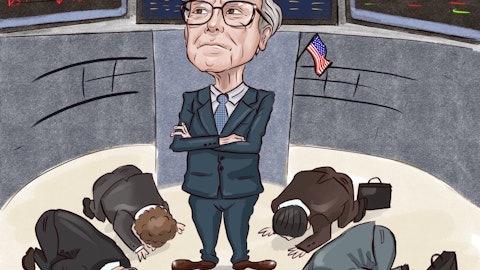So we are going to be, say, having a first responsibility vis-a-vis the patients, while still optimizing to a degree where it both benefit patients and our ability to scale.
Daniel Bohsen: Thank you, Lars. Thank you, Martin. So we’ll take the next question.
Operator: Thank you. One moment please. The next question comes from the line of Richard Vosser from JPMorgan. Please go ahead.
Richard Vosser: Hi, thanks for taking my questions. Two questions, please. First question, just could you update us on the payer discussions around SELECT and how you see rebate pressure in ’24 for the obesity franchise given it’s still supply constrained particularly in the U.S. and the second question also thinking about diabetes, we’ve seen a consistent sort of 10% to 15% rebate pressure in the U.S. around Ozempic, Rybelsus and in the Type 2 side. Is that how we should think about the pressure going into 2024? Thanks very much.
Lars Fruergaard Jorgensen: Thank you, Richard. And then, Doug, I’ll give the word to you for SELECT payer discussions, what you can say and then also competitive dynamics in diabetes?
Doug Langa: Yes, thank you for the question, Richard. Really appreciate it. So just to reiterate, we’re super excited about the potential of SELECT data and we do eagerly await the whole full label update in the coming months. And we’re doing our normal preparation for that. When we think about what that means certainly for Part D access, we’re hopeful that SELECT can unlock some of that access, but in the end, even with the excellent data, it’s likely not going to happen overnight. But in the end, we believe that SELECT can set Sema 2.4 milligram apart as the first and only AOM showing a consistent benefit across endpoints including MACE. So we’re super excited about that.
Richard Vosser: And the second part doc of the question with regards to competitive dynamics in the GLP-1 diabetes space?
Doug Langa: Yes. So overall, we see a stable competitive environment. Obviously, as we see an increase in volume, we should expect to see also a decrease in price over time as the product gets larger in the marketplace. But again, it’s a stable competitive environment that we have.
Daniel Bohsen: Thank you, Doug. Thank you, Richard for the questions. Next questions, please.
Operator: Thank you. One moment please. The next question comes from the line of Harry Sephton from UBS. Please go ahead.
Harry Sephton: Great, and thank you very much for taking my questions. Maybe just for the first question back to Doug. So you mentioned that you’ve seen a stable competitive environment in the U.S. But just wanted to question whether you’ve observed any changes to position for Ozempic in the U.S. through 2023 and whether that impacted prescription growth for Ozempic in the fourth quarter? And then my second question is on the stay time on therapy for patients. So firstly, an update on what you’re seeing for Wegovy, but also whether the observed stay time on Ozempic has changed at all over the last year and what might be driving that? Thank you.
Lars Fruergaard Jorgensen: Thank you, Harry. So, Doug, any comments to formulary stages for key products? And then the stay time I will give to Camilla.
Doug Langa: Yes, thanks, Harry. So overall, we don’t see any major change to formulary status for GLP-1s. And if again, you recall, we have more than 90% unrestricted access, so very favorable access and we see that largely unchanged in 2024 this year.
Camilla Sylvest: Good. And on stay time, what we can say is that we generally see a better stay time on Wegovy than what we’ve seen on previous anti-obesity treatment like Saxenda, so we basically see fewer patients dropping out. And it’s still early days for Wegovy because of the interrupted supply in the countries, but we can also say that both in the U.S. but also in Denmark, we see strong indications that the stay time is longer for Wegovy. And especially in Denmark, we see the majority of the patients who initiated treatment in the beginning of last year, they stayed on the treatment throughout the year. And on Ozempic, generally we see a continued long stay time in the June of four to five years. So there’s been no major changes to that.
Daniel Bohsen: Thank you, Camilla and Doug and thanks for the question, Harry. So we’ll take the next question.
Operator: Thank you. One moment please. The next question comes from the line of Emily Field from Barclays. Please go ahead.
Emily Field: Hi, thank you. I have two questions. The first is just on the guidance range for revenue growth at constant exchange rate, it is quite a wide delta between 18 and 26. Could you just give us some color on the guidance between that? Is that primarily the cadence that Wegovy supply coming on and anything else post Wegovy and then another question just on commercial coverage in the United States, you’ve pretty consistently indicated that in that commercial size about 50% of employers in the U.S. are you expecting any major changes to that in 2024? Thank you.
Daniel Bohsen: Thank you, Emily. The sound was a bit bad. But I think we got your question. So Karsten, any color on the guidance ranges? And then later, Doug, coverage of Wegovy in the U.S.?
Karsten Munk Knudsen: Thank you for that question, Emily. And yes, you’re correct. Guidance ranges are not broader than what they had normally been at this point in time. And of course, the plan is to narrow guidance ranges over the years as time progresses. The reason why we’ve chosen to broaden them slightly is basically the dynamics we’ve seen over the past quarters in 2023 and even in 2022. So a dynamic market and constrained supply and growth to net adjustments linked to the U.S. gross-to-net model. So, fundamentally, there are no major fundamental changes to what we’ve seen in prior quarters. We just felt that it was more prudent at the beginning of the year to start out with a notch wider guidance ranges.




